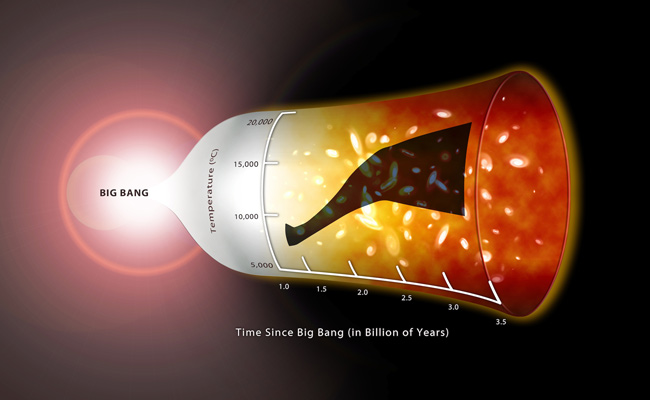Black Holes Gave Our Baby Universe a Fever

The young universe spiked a fever 1.5 billion years or so after the Big Bang, warming up as huge black holes poured out massive amounts of energy, a new study suggests.
The find is something of a surprise, since the universe is generally thought to have cooled down over time. But from 12 billion to 10 billion years ago or so, ultraviolet light emitted from black holes at the centers of galaxies seems to have heated up the gas that spread throughout the cosmos, researchers report. [New illustration of cosmic heating.]
"One billion years after the Big Bang, the gas we measured was a 'cool' 8,000 degrees Celsius [14,432 degrees Fahrenheit]," said study lead author George Becker of the University of Cambridge. "By three and a half billion years, the temperature had climbed to at least 12,000 degrees Celsius [21,632 Fahrenheit]."
Studying quasar light
Becker and his colleagues measured the temperature of ancient gas clouds pervading the universe. In the universe's youth, these clouds were much more extensive, since many of them hadn't yet coalesced to form stars and galaxies, the researchers said.
The scientists took the temperature of the gas by studying the light from distant objects called quasars, using the Keck telescopes in Hawaii. Quasars are thought to be black holes swallowing up material at the center of galaxies, emitting lots of ultraviolet light and other radiation in the process.
Since distant objects' light takes so long to reach us, the views we see represent how they looked long ago, and astronomers are able to essentially look back in time.
Sign up for the Live Science daily newsletter now
Get the world’s most fascinating discoveries delivered straight to your inbox.
"The gas, which lies between us and the quasar, adds a series of imprints to the light from these extremely bright objects," Becker said. "By analyzing how those imprints partly block the background light from the quasars, we can infer many of the properties of the absorbing gas, such as where it is, what it's made of and what its temperature is."
The quasar light had traveled more than 10 billion light-years by the time it reached Earth, researchers said, and thus had passed through vast stretches of ancient cosmic gas. Researchers found a clear indication that the temperature of the gas had increased steadily over the period from when the universe was about 1.5 billion to 3.5 billion years old.
This was something of a surprise, researchers said, because the gas should have been cooling down as the cosmos expanded during this epoch. Something substantial must have been heating the gas.
"The likely culprits in this intergalactic warming are the quasars themselves," said co-author Martin Haehnelt, also of Cambridge University.
Quasars were becoming much more common during this time, Haehnelt said, and they would thus have been emitting lots of gas-heating ultraviolet light.
The role of helium
One of the lightest and most abundant elements in the intergalactic gas clouds, helium, played a vital role in the heating process, researchers said.
Ultraviolet light would have collided with helium atoms, knocking out electrons that would then go on to collide with other atoms and heat up the gas. Once the supply of fresh helium was exhausted, the universe started to cool down again. Astronomers believe this probably occurred after the cosmos was about 3.5 billion years old.
The researchers report their results in a forthcoming issue of the journal Monthly Notices of the Royal Astronomical Society.
- The Big Bang: Solid Theory, But Mysteries Remain
- Top 10 Strangest Things in Space
- Video: Black Holes: Warping Time and Space
This article was provided by SPACE.com, a sister site of LiveScience.com.










